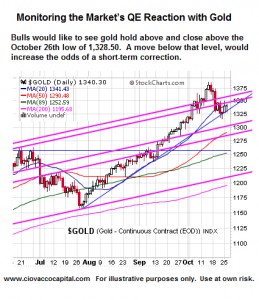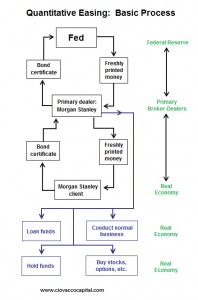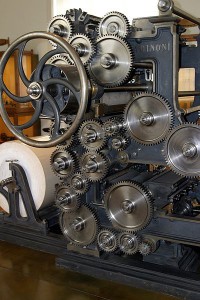This is part 4 in the video series on the effects of Quantitative Easing by Chris Ciovacco the Chief Investment Officer for Ciovacco Capital Management. To see the other parts How the FED Prints Money, How the FED Prints Money – Part 2, How The FED Prints Money- Part 3 … [Read more...]
How The FED Prints Money- Part 3
Last week we looked at who gets all the money the FED prints and before that we looked at the process the FED uses to get the money "Out of Thin Air" and into the hands of people who can spend it. Today we are going to look at what is "Quantitative Easing" well it sounds cool anyway... ~editor What is Quantitative Easing? Fed’s Perspective & Writings Part 3 in a 6 Part Video Series on Quantitative Easing A Wall Street Journal article (10/27/10) on quantitative easing (QE) hints the Fed will take a middle of the road approach in terms of the size and duration of QE2. As we would expect, the stock and commodity markets’ initial reaction is negative. A middle of the road … [Read more...]
How the FED Prints Money – Part 2
Yesterday we looked at the process the FED uses to get the money "Out of Thin Air" and into the hands of people who can spend it. In other words the "how" they do this magic. Basically, that route is through special dealers and then it goes into a few select hands. Today we are not going to look at the "how" but instead we will look at "Who" gets the money and where it is likely to go from there. Because if we know where it is likely to go we can get there first and profit from the incoming cash flow. ~Tim McMahon, editor Quantitative Easing (QE2): Who Gets the Fed’s Printed Money? Part 2 of a 6 Part Video Series on Quantitative Easing: In Part 1: How the FED Prints Money, we … [Read more...]
How the FED Prints Money
Printing Money: The process of "printing" money is always a kind of mystery to most people since only about 10% of the total money supply is actually in physical currency. Technically most of the money isn't printed so the term should be "money creation" or "money supply expansion" but "printing money" is used euphemistically to include all forms of expanding the money supply. The monetary base (or money supply) is typically controlled by adjusting monetary policy. This is usually done by the central bank (in the U.S. this is the Federal Reserve Bank or FED). The FED changes the monetary base through "open market transactions" (i.e., buying and selling of government bonds). The FED also … [Read more...]
Which is Stronger- Inflation or Deflation?
By Tim McMahon, editor Why the Printing Press is No Match for Deflationary Forces- A mere two years ago (although it seems like a lifetime) in August of 2008, inflation was roaring in at 5.37% and the world was talking about hyperinflation. But then along came the housing crash which started the domino effect of deflationary forces. Housing prices, stock prices, asset prices all began falling; triggering margin calls and more liquidation until even Gold (the only investment that is not simultaneously a liability) began to feel the deflationary pressure. By July 2009 a mere 11 months later, everyone was no longer afraid of the inflation monster, but now they were fearing deflation. At … [Read more...]
Why would Gold fall during an Investment Crisis?
Editor's Note-- In the article Is Gold really a good Inflation Hedge? I said, Gold is actually a "crisis hedge." So it should be performing extremely well with all the uncertainty in the markets right now. In this article Andrew Gordon explains how gold is currently in limited supply and demand is booming due to the crisis and what is currently affecting the price. -- Tim McMahon, editor Has Gold Lost its Investment Luster? By Andrew Gordon Gold dropped from $915 to $859 on Friday [October 10, 2008]. That’s not supposed to happen while the market is crashing. What’s going on? … [Read more...]




